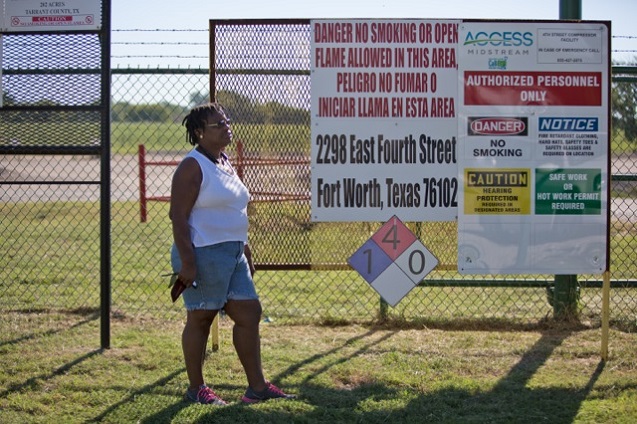
Part of the Series
Gas Rush: Fracking in Depth
When a representative from Chesapeake Energy knocked on Phyllis Allen’s door in 2003 and offered $300 for her mineral rights and an invitation to a lease-signing pizza party, she turned them down.
Allen’s home is in the United Riverside neighborhood, predominately poor and working class African American, the place where fracking first took hold in the city. She’d like to say she didn’t sign because of her concerns for environmental issues but, at the time, she hadn’t heard of fracking.
She didn’t sign because of the advice her father gave her: “Never sign anything you don’t understand.”
Since then, Phyllis Allen, a retired Yellow Pages sales representative, has educated herself about fracking. During her daily walks along the Trinity River she takes note of environmental problems. In 2011, she saw a white chemical cloud rising over a compressor center and workers in hazmat suits going in to shut it down.
In another instance, Allen witnessed fluid being pumped into the Trinity River during the peak of the drought. She contacted Streams and Valleys, the organization responsible for the trails along Trinity, but never found out exactly what was going on. And she’s noticed that migratory birds don’t come back to the riverbank anymore.
Fort Worth, which sits on top of the vast Barnett Shale is the first major city in America to allow extensive fracking within the city limits.
The city has approximately 2,000 gas wells and more are being drilled. Though there is an ordinance to keep fracking 600 feet from residences, exceptions are made. In some locations fracking happens 300 feet from homes and businesses.
As far as Allen knows, none of her neighbors resisted signing the leases.
“The poor and working class don’t have fracking on their radar. They are worried about making house and car payments and don’t have time to follow environmental issues in their community,” she says.
“White people fight back when they see something wrong being done in their neighborhoods because they believe the system is just. Black people already know that the system is stacked against them so they are less likely to get involved. That’s why the frackers started here. It is not correct to simply say the African American community is apathetic about fracking. You need to consider there is a growing group of people who have less and less, with little chance of standing up to the 1 percent, so they don’t protest.”
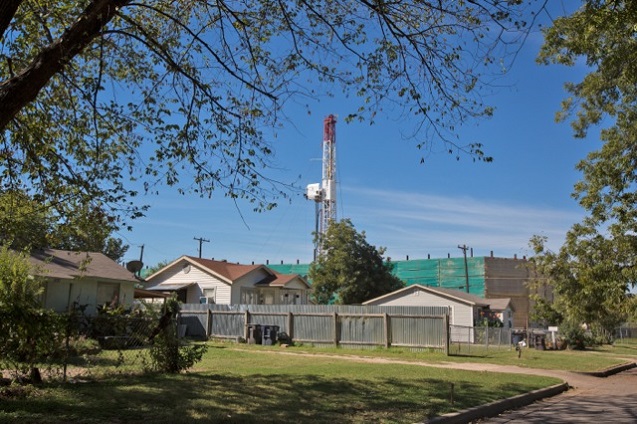 Fracking site in residential neighborhood in Fort Worth. (Photo: ©2013 Julie Dermansky)
Fracking site in residential neighborhood in Fort Worth. (Photo: ©2013 Julie Dermansky)
Don Young, a stained glass artisan in Fort Worth’s predominantly middle class West Meadowbrook neighborhood got a knock on his door from the representative of a fracking company a few years after Allen did. Young also started researching fracking and has become one of the industry’s largest adversaries in the area, founding Fort Worth Citizens Against Neighborhood Drilling Ordinance.
Despite small victories, including stopping the Tandy Hills Natural Area from being fracked, Young recently put his house on the market.
“Fort Worth has been fracked to capacity,” according to Young. “There is no turning back. Some days the air is so bad you can’t see downtown.”
 Don Young at his father’s burial site in Handley Cemetery in Fort Worth, where frackers have obtained drilling rights. (Photo: ©2013 Julie Dermansky)
Don Young at his father’s burial site in Handley Cemetery in Fort Worth, where frackers have obtained drilling rights. (Photo: ©2013 Julie Dermansky)
When a well is first fracked industry recovers what is known as the mother lode. The bulk of the natural gas or oil is harnessed from the drill site during the first year.
The yield greatly decreases after that, so companies cap wells and drill new ones. They then move to sites previously leased, ensuring they get to tap into all the leased properties before any of the leases expire.
Once a well is drilled they can come back to re-frack. When gas prices go up, re-fracking existing wells will become a profitable venture even with a much smaller rate of return.
When that happens, Young says, “Fort Worth will be a horrible place to live.”
Fracking in Fort Worth knows no boundaries. Wells are drilled next to schools, parks and cemeteries. Despite the risks — health hazards from increased air and water contamination; water shortages exacerbated by the industry’s need for millions of gallons of water; the imminent danger of ruptured gas pipelines and earthquakes — few are fighting back.
The fracking companies have spread a lot of money around to cultural centers and church groups to curry favor and reassure residents.
In the Fort Worth Museum of Science and History, they have interactive fracking displays, including a game with joysticks for directional drilling. These public relations moves help keep would-be opposition factions at bay.
“While we have grown complacent, the fracking industry has chipped away at our quality of life big time,” Young says.
Watch me test out the joystick operated horizontal drilling game in the Fort Worth Museum of Science and History:
If only it were that straight-forward in reality.
How Arlington Fell to the Frackers
Fort Worth was the first major city in America to allow extensive fracking within the city limits — but it wasn’t the last. Arlington, Texas, fell to the frackers next — only this time, the frackers were required to make their installations less of an eyesore.
Berms were built up around fracking sites and compressor centers to hide them from view, and active drill sites have temporary walls built up around them to keep the noise down. But walls don’t stop chemical seepage.
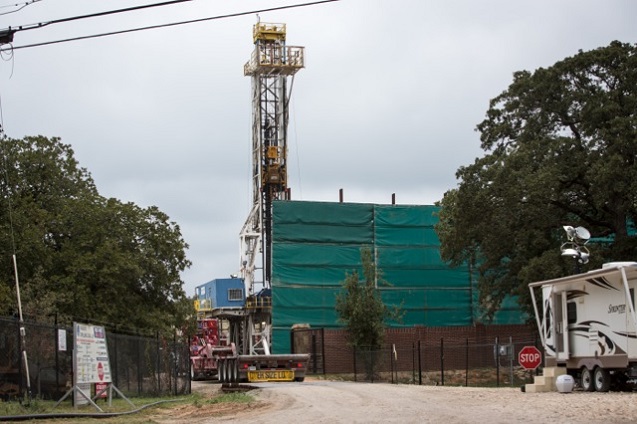 Fracking site in Arlington, Texas, a suburb of Dallas. (Photo: ©2013 Julie Dermansky)
Fracking site in Arlington, Texas, a suburb of Dallas. (Photo: ©2013 Julie Dermansky)
Kim Feil, an educator, blogger and environmental activist, is no stranger to chemical exposure. She moved from New Sarpy, Louisiana, part of an area known as Cancer Alley due to its many refineries and high incidence of cancer, to Arlington, before the fracking began.
Feil monitors new industrial developments and does what she can to stop them by attending city-zoning meetings. Her blog keeps neighbors informed about what is coming next and which fracking installations are having problems. Other concerned citizens share heartbreaking stories with her about sicknesses they believe are connected to fracking.
Since the fracking began, Feil’s husband has been diagnosed with cancer, she started experiencing migraines and her son has a biomarker for an adrenal tumor.
Though it is difficult to directly link illness to industrial pollution with the present limited scientific data, she has no doubt that the new and troubling health problems around her are connected to fracking.
Earthworks released video footage that documents chemicals escaping into the air at frack sites, captured with an infrared camera. Though the naked eye can’t see chemicals escaping from water storage holding tanks and frack sites, infrared cameras can. Cancer-causing chemicals associated with fracking include hydrogen sulfide, sulfur dioxide and methane.
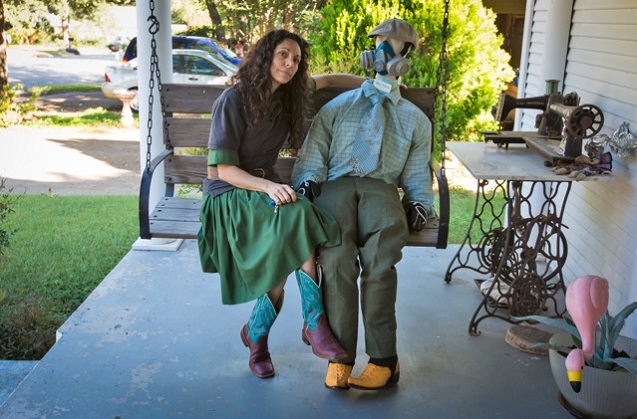 Kim Feil on her front porch in Arlington with dummy “Ben Zene,” a prop she brings with her when protesting fracking. (Photo: ©2013 Julie Dermansky)
Kim Feil on her front porch in Arlington with dummy “Ben Zene,” a prop she brings with her when protesting fracking. (Photo: ©2013 Julie Dermansky)
Ranjana Bhandari and her family live in an upscale area of Arlington. She turned down an $18,000 per acre bonus for her mineral rights, only to find that the Texas Railroad Commission could strip those rights from her by applying Rule 37.
A law originally meant to protect property owners, Rule 37 has been interpreted by frackers in a way that enables them to seize the drilling rights when a landowner refuses to sign a lease after most of their neighbors have consented.
Bhandari’s challenge to Chesapeake Energy resulted in a hearing before the Texas Railroad Commission. The commission ruled in Chesapeake’s favor.
According to Reuters, Texas Railroad Commission spokesperson Ramona Nye said the agency believes there is no evidence that fracking is unsafe. Evaluating the fairness of Rule 37 exceptions is not part of the commission’s mandate, she said.
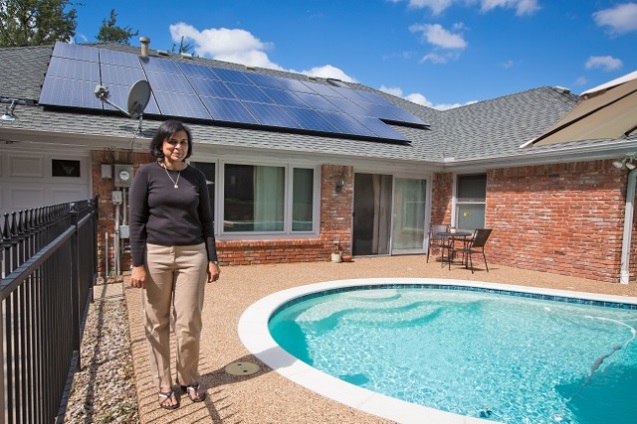 Ranjana Bhandari in front of solar panels on her home in Arlington, Texas. (Photo: ©2013 Julie Dermansky)
Ranjana Bhandari in front of solar panels on her home in Arlington, Texas. (Photo: ©2013 Julie Dermansky)
Bhandari doesn’t have the means to hire a lawyer and take the case further. Although she couldn’t stop her land from being fracked, she is glad she never consented.
At a meeting on October 10th, at the Preston Royal Library in Dallas, FracDallas director Marc W. McCord gave a talk on fracking’s impact on the water supply. McCord went over the staggering figures: two to six million gallons of water are used for each well, threatening to further deplete an already dangerously low water supply. According to Mr. McCord’s presentation, “in the Barnett Shale the range is about 1.5 to 9 million gallons with an average of about 5 million gallons per well. In the Eagle Ford the average is about 9 million gallons with a high of about 13 million gallons.”
Although industry representatives point out fracking uses only one percent of Texas water, that statistic is misleading since water use is not the same in all areas.
In areas such as Arlington, Fort Worth and south of San Antonio, which are facing worsening drought conditions, taking any portion of water out of public use threatens to leave cities entirely dry.
McCord also dispelled the talking point that natural gas burns cleaner than coal. “The energy used to retrieve fracked gas and oil is more carbon intensive than burning coal,” he says. “The problem isn’t using the gas, but getting it.”
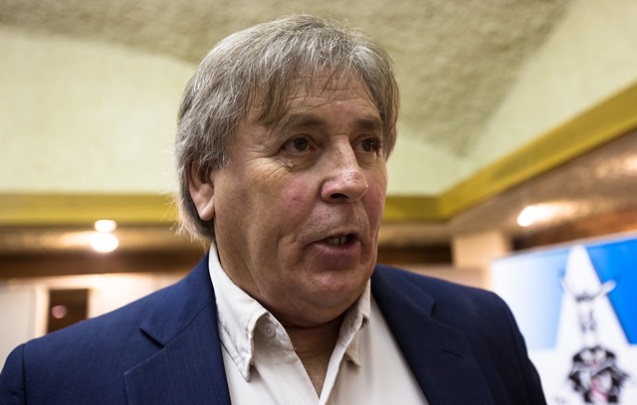 Marc W. McCord, Director of FracDallas, speaks at the Preston Royal Library. (Photo: ©2013 Julie Dermansky)
Marc W. McCord, Director of FracDallas, speaks at the Preston Royal Library. (Photo: ©2013 Julie Dermansky)
Although the long-term effects of fracking are still being debated, some of the risks involved in harvesting this unconventional energy source are already clear.
Millions of gallons of water are removed from public use — water that cannot be recycled due to contamination and must be removed from the water supply for good. The hydrogen sulfide released from fracking sites can be lethal. Gas pipelines can explode. And recent studies show fracking is causing earthquakes.
Fueling the debate are oil and gas corporations that have compromised scientific studies by underwriting them and are starting to run “native advertisements” that blur the line between news and advertising.
To frack in densely populated cities increases the potential risk to life and property exponentially. Whatever financial boon fracking can bring, it can also lower property values if the water and air become contaminated.
Dallas has safeguarded the city with zoning restrictions, which make fracking within city limits unattractive. Residents of Dallas who keep an eye on Arlington and Fort Worth have seen enough of fracking’s downsides to spur them to keep fracking outside the city limits — for now.
Watch an animated display about fracking at the Forth Worth Museum of Science and History:
Our most important fundraising appeal of the year
December is the most critical time of year for Truthout, because our nonprofit news is funded almost entirely by individual donations from readers like you. So before you navigate away, we ask that you take just a second to support Truthout with a tax-deductible donation.
This year is a little different. We are up against a far-reaching, wide-scale attack on press freedom coming from the Trump administration. 2025 was a year of frightening censorship, news industry corporate consolidation, and worsening financial conditions for progressive nonprofits across the board.
We can only resist Trump’s agenda by cultivating a strong base of support. The right-wing mediasphere is funded comfortably by billionaire owners and venture capitalist philanthropists. At Truthout, we have you.
We’ve set an ambitious target for our year-end campaign — a goal of $250,000 to keep up our fight against authoritarianism in 2026. Please take a meaningful action in this fight: make a one-time or monthly donation to Truthout before December 31. If you have the means, please dig deep.